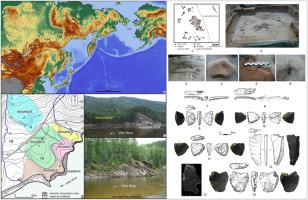西伯利亚贝加尔湖-帕托姆高原科夫里日卡四号遗址的发掘及其对晚期上旧石器时代晚期和人类适应末次盛冰期环境研究的意义
IF 1.8
3区 地球科学
Q3 GEOGRAPHY, PHYSICAL
引用次数: 0
摘要
19-18 ka BP的Kovrizhka IV遗址的考古组合,允许重建一套旧石器时代晚期晚期早期居民的文化传统-末次冰期末期,详细介绍了诸如石器加工,食物供应,住宅和壁炉的建造,流动性和象征性活动等方面。Kovrizhka IV被确定为一系列季节性住宅营地,位于海滩线上,靠近一个岩石海角的悬崖,突出到Vitim河。在文化层6、3 B、3/2、2 g出土了民居遗迹,在文化层2 B出土了壁炉遗迹。在两个案例中,生活区被涂上或撒上了赭石碎片。总之,现有资料表明,在适应和生存LGM条件方面,这种稳定、繁殖成功的生活方式持续了大约500年。岩屑加工技术记录在微刀片、大刀片、粗棱柱刀片、薄片、双面和单面的表面加工以及通过石墨垂饰、研磨和钻孔技术来判断的背景下。Yubetsu的微刃压击技术为科夫里日卡四号的人所熟知,但另一种技术,被称为科夫里日卡方法,在空白选择和核心旋转方面更加机会主义,占主导地位。科夫里日卡4号的其他石器生产表明,保存传统的累积性质可以追溯到西伯利亚旧石器时代早期(大刀片)和旧石器时代中期(粗棱柱刀片)。主要的相应文化被确定为外贝加尔南部LUP的Studenoye文化和雅库特的Dyuktai文化。总的来说,岩屑工业,特别是压扣微叶片技术,具有明显的连续性,从科夫里日卡IV到贝加尔湖-帕托姆高原的最终MIS-2遗址,如Bolshoi Yakor I, Avdeikha和科夫里日卡III。这种文化被描绘成一种本地适应性的集合,有助于对东北亚早期LUP文化的总体看法。就居住特征、工具箱、微刀片生产和拟人化雕像而言,科夫里日卡四号在整个北贝加尔湖西伯利亚地区是独一无二的,对旧石器时代晚期晚期东北亚的总体概况做出了重大贡献。本文章由计算机程序翻译,如有差异,请以英文原文为准。

Excavations at Kovrizhka IV site and its bearing on research of the Late Upper Paleolithic and human adaptation to the environment of last glacial maximum in Baikal-Patom Highlands, Siberia
The archaeological assemblages of the Kovrizhka IV site, 19–18 ka BP, allows for the reconstruction of a set of cultural traditions of the inhabitants of the early phase of the Late Upper Paleolithic – the end of the Last Glacial Maximum detailed in such aspects as lithic processing, food supply, construction of dwellings and hearths, mobility, and symbolic activity. Kovrizhka IV has been identified as a series of seasonal residential camps on the beach line near a cliff of a rocky cape protruding into the Vitim River. Remains of dwellings were excavated in cultural horizons 6, 3 B, 3/2, 2G and remains of a hearth feature in cultural horizon 2 B. In two cases, the living area colored or sprinkled with ochre pieces. In summary, the existing data characterize a stable, reproductively successful lifestyle in terms of adaptation and survival to the conditions of the LGM lasting approximately 500 years. The lithic processing techniques documented in the contexts of the production of microblades, macroblades, coarse prismatic blades, flakes, facial finishing of bifaces and unifaces, and judging by the graphite pendant, grinding and drilling techniques. The Yubetsu technique of microblade pressure knapping was known to the people at Kovrizhka IV, but another technique, called the Kovrizhka method, much more opportunistic in terms of blank choice and core rotation, was dominant. The rest of the lithic production at Kovrizhka IV demonstrates the cumulative nature of the preservation of traditions dating back to the Early Upper Paleolithic (macroblades), and the Middle Upper Paleolithic (coarse prismatic blades) of Siberia. The main corresponding cultures are identified as the Studenoye culture of the LUP in southern Transbaikalia and the Dyuktai culture of Yakutia. In general, the lithic industry, and especially the technique of pressure knapping microblades, is characterized as a demonstrable continuity from Kovrizhka IV to sites of the Final MIS-2 of the Baikal-Patom Highlands such as Bolshoi Yakor I, Avdeikha, and Kovrizhka III. This culture is portrayed as a local adaptive set, contributing to the general ideas about the culture of the early LUP of Northeast Asia. In terms of dwelling features, toolkits, microblade production, and anthropomorphic figurines, Kovrizhka IV is unique for the whole of North Baikal Siberia, and makes a significant contribution to the general panorama of late Upper Paleolithic Northeast Asia.
求助全文
通过发布文献求助,成功后即可免费获取论文全文。
去求助
来源期刊

Quaternary International
地学-地球科学综合
CiteScore
5.60
自引率
4.50%
发文量
336
审稿时长
3 months
期刊介绍:
Quaternary International is the official journal of the International Union for Quaternary Research. The objectives are to publish a high quality scientific journal under the auspices of the premier Quaternary association that reflects the interdisciplinary nature of INQUA and records recent advances in Quaternary science that appeal to a wide audience.
This series will encompass all the full spectrum of the physical and natural sciences that are commonly employed in solving Quaternary problems. The policy is to publish peer refereed collected research papers from symposia, workshops and meetings sponsored by INQUA. In addition, other organizations may request publication of their collected works pertaining to the Quaternary.
 求助内容:
求助内容: 应助结果提醒方式:
应助结果提醒方式:


